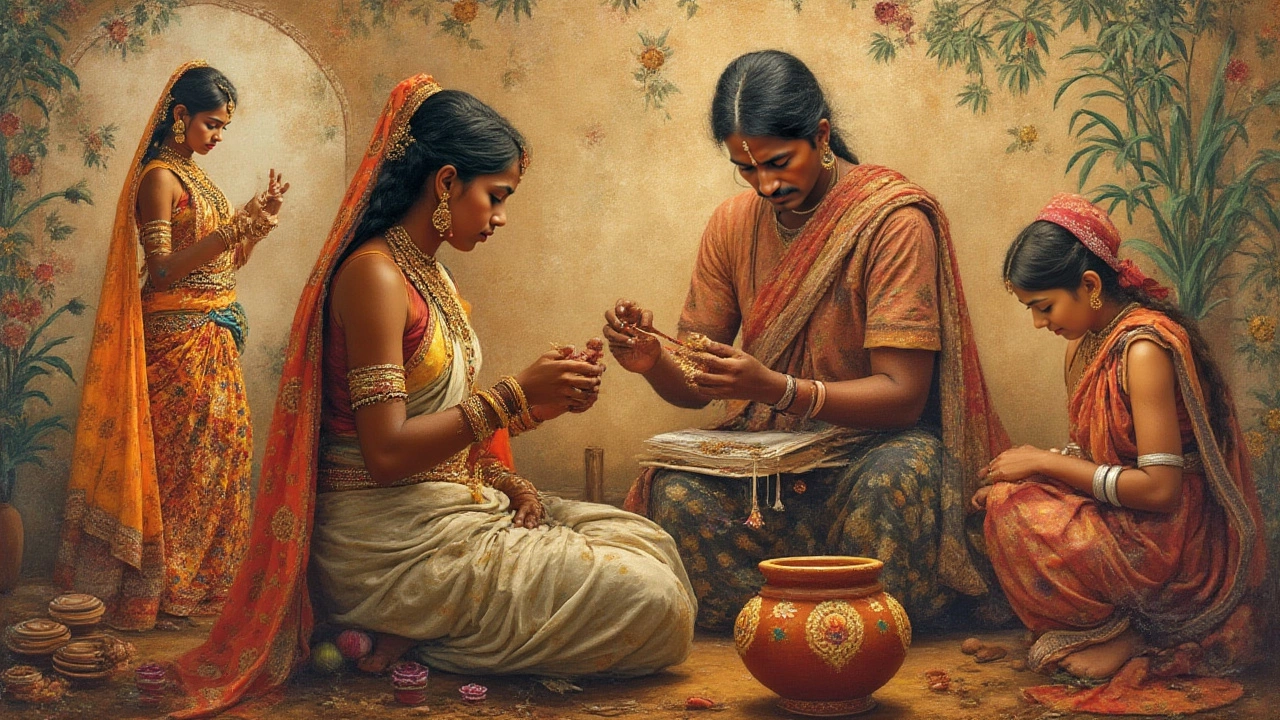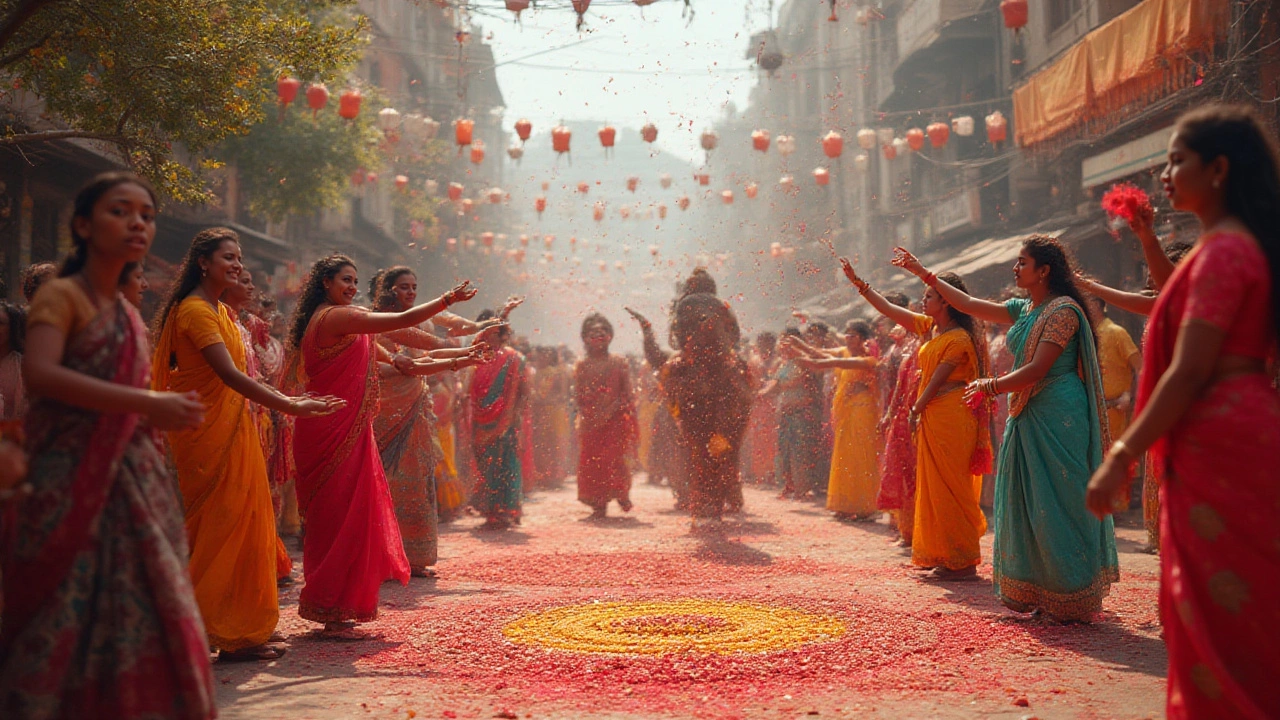Ever tried counting the colors in an Indian festival? Spoiler: you'll lose track. That's the magic of India. It's not just a country—it's a whole mood, an explosion of tradition with millions of people doing a million different things. From the Himalayas slicing the sky to coconut palms in Kerala swaying to the monsoon, it's all stitched together by something you can't see, but you feel everywhere: India's cultural heritage. It's loud and proud, sometimes chaotic, always full of life. Let’s figure out what makes this place a living museum with actual people as the exhibits.
Roots That Go Way Back: Traditions, Languages, and Ancient Wisdom
Sometimes you catch a grandmother singing a lullaby, and that tune goes back 2000 years or more. India's cultural heritage starts with roots that run ridiculously deep. In fact, the Indus Valley Civilization was already hustling with city life and social rules while much of Europe was still figuring out farming. Sanskrit, one of the world's oldest languages, came out of India, and you still hear bits of it in modern prayers, poetry, and yoga classes. India isn't just multilingual—it's hyperlingual. According to the 2011 Census, over 19,500 languages and dialects are spoken here. Even if you travel just 100 kilometers, you’ll find people saying hello in a whole new way. It's wild but true.
Let's talk traditions. Every morning, millions light oil lamps, offer flowers, and ring bells—not just for the rituals, but for the memories carried in those rituals. Some things, like the joint family system, make modern sociologists scratch their heads. But it's not about being old school; it's about mixing wisdom with practicality. The idea of 'Atithi Devo Bhava'—guest is God—means you’ll rarely leave an Indian house hungry or thirsty, even if you drop by unannounced.
Ayurveda, yoga, and meditation? Born in India before finding fame in California gyms. The concept of 'ahimsa' (non-violence), which Gandhi turned into a global movement, also started right here. And if you love numbers—Indians came up with zero. That alone rewrote the world’s math books. But here's something quirky: Indians created chess too, calling it chaturanga, and it traveled West, getting a new name and set of rules along the way.
The World Painted in Color: Indian Art, Architecture, and Music
Step into any street and you'll see art bursting out of every corner. Indian art isn't just about pretty paintings or sculptures—it's woven right into city walls, saris, and even mud thatched homes in tribal villages. Look up some time in Jaipur: those block-printed fabrics have patterns passed down for centuries. Take the tribal Warli paintings from Maharashtra; those stick figures tell stories about daily life that museums snap up today. Or the Kalamkari craft of Andhra Pradesh that transforms plain cotton into storytelling canvases using pen and natural dyes. The making of terracotta horses in Tamil Nadu? Feels like magic, but it’s just hundreds of years of practice.
Now, the architecture—let’s not even get started on the Taj Mahal. But okay, let’s—a staggering 7-8 million visitors show up every year just for that one marble wonder. But step off the regular tourist trail, and you’ll stumble into temples like the intricate Meenakshi Temple in Madurai, or the step-wells of Gujarat that look like upside-down palaces. India’s mosques, temples, churches, and forts tell stories of kings, wanderers, scholars, and rebels—each leaving their stamp.
Music here isn’t just Bollywood songs (though, who can resist a catchy number?). Indian classical music splits into Hindustani (north) and Carnatic (south) styles, each more complicated than most pop stars could ever dream. Ever heard a live sitar or tabla? You’ll feel goosebumps even if you know nothing about the raga being played. Folk music and dances—like Rajasthan’s Ghoomar or Assam’s Bihu—turn regular fields and courtyards into wild party spaces. And don’t forget Bollywood: India makes more movies than Hollywood, and practically every film is a musical. Not every tradition feels ancient—sometimes they just make new ones and run with it.

The Taste of India: Food, Spice, and Shared Meals
If you ever thought Indian food is all about curry, you haven’t really tasted India. The word 'curry' actually means almost nothing here; it’s outsiders trying to label a galaxy of flavors. Indian cuisine changes every 50 kilometers. The spices? It’s not just about heat; it’s about layering flavor—coriander, cumin, cardamom, asafoetida, fenugreek, the list goes on. More than 70% of the world’s spices are grown in India. Every meal bows to local geography. In Goa, coconut and fish run the kitchen; in Punjab, wheat and dairy reign; in the South, rice and tamarind paint the plate.
You know what’s amazing? The thali—a round platter with ten or twelve (sometimes more!) mini-dishes, so you taste everything from sweet to sour to spicy in one go. Sharing food is a tradition that’s almost spiritual. During big festivals, the whole town might line up for a free 'langar'—mass meals dished up from huge steel vats, served with no questions about religion or status. The practice started with Sikh Gurus, but now everyone joins in. And if you visit during a festival—you absolutely must, if the chance comes—get ready for sweet gulab jamuns, laddoos, and jalebis that would shame any Parisian pâtisserie.
Don’t forget street food! In Mumbai, vada pav is king, a spicy potato burger that costs less than a soda. In Delhi, chaat stalls sling tangy, crunchy things you eat with your hands. In Kolkata, they serve spicy rolls in paper that you carry while speeding through the city traffic. Respect your stomach, though—Indian street food can be a wild ride for newcomers.
Festivals and Diversity: All Together, But Gloriously Different
If you want to see India’s cultural heritage in real time, crash a festival. Honestly, there are more festivals than days in the year here. You’ve got Diwali (the Festival of Lights), Holi (the Festival of Colors), Eid, Christmas, and Pongal littering the calendar. Then come the hundreds of local and tribal festivals—Pushkar Camel Fair, Onam, Durga Puja, Ganesh Chaturthi. Each comes with its own music, food, and rituals.
One of the coolest things? India has managed to stay incredibly diverse without everyone melting into the same thing. Most families celebrate their festivals and invite their neighbors over—sometimes for the fun, sometimes for the food, always for both. Even work holidays try to include the major festivals of all religions. Here’s a fun fact: India has six major religions that officially enjoy government recognition. The Constitution lists 22 official languages, and no state government expects you to speak just one. You might see a Christian procession winding past a mosque down the road from a Hindu temple, all trading sweets in December.
And then there's diversity beyond religion. Tribal people in the Northeast and central India grow rice, weave their stories into shawls, or hunt and gather using skills that go back millennia. In Rajasthan, nomadic groups like the Kalbelia perform snake dances that stun tourists and locals alike. Across India, LGBTQI+ communities have their own traditional support networks—'hijra' communities date back hundreds of years, with a mix of respect and struggle that’s complicated but fascinating.
| Interesting Fact | Detail |
|---|---|
| Religions Practiced | Hinduism, Islam, Christianity, Sikhism, Buddhism, Jainism, Zoroastrianism, Judaism |
| No. of Official Languages | 22 (Hundreds spoken informally) |
| Festivals Per Year | Over 365, including local forms |
| World Heritage Sites | 42 UNESCO-recognized sites |
| Most Visited Monument | Taj Mahal (7-8 million visitors annually) |
| Key Spice Producing Country | India (over 70% of world’s spices) |
Here's a tip if you travel: Ask the elders for a story, attend a local festival, eat at a 'dhaba' (roadside eatery) if you want the real taste, and always look up—ceilings in Indian homes and temples hide fantastic art. Oh, and watch where you step; there may be a floor painting ('kolam' or 'rangoli'), meant to invite fortune into the home. India's heritage isn't hidden in museums—it's alive, and it wants to share a meal, a dance, or a story with you.
